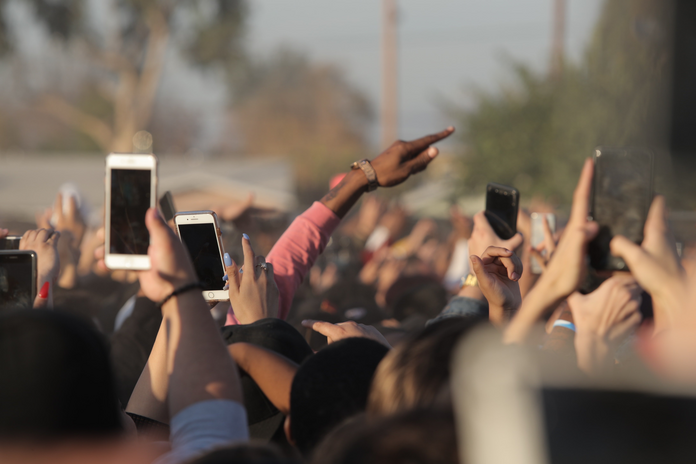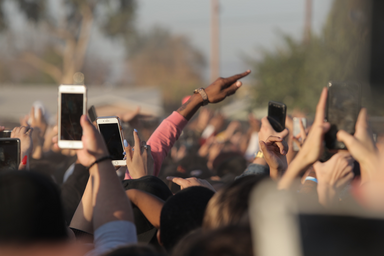Social media faux pas can be just as embarrassing as real-life gaffs. We’ve all made ‘em and had to cringe and get over it, which is luckily not too difficult. Unless it was a major scandal like accidentally sending a nude photo of yourself to your Facebook instead of your boyfriend, an infraction of the “rules” probably won’t affect your life too much if your profile is private. LinkedIn, however, is a bit of a different story. If a potential employer sees something cringe-worthy on your profile, well, you may have just lost a job opportunity. Here are some examples of what not to include on your profile so you can avoid this situation.
1. “LOL OMG!”
Things like this may be okay for Facebook, but they’re definitely not LinkedIn-appropriate. “No ‘lol,’ and make sure that you’re spelling out all your words,” says Veronica Soto, the assistant director of career events at the University of Miami’s career center. “You don’t want to do the ‘w’ with the slash. You want to make sure that you’re writing an actual document. You want to stay away from the netspeak.”
Typing as if you’re g-chatting with your best friend is unprofessional, so stick to fully formed words and thoughts. LinkedIn really isn’t the place for LOL-worthy stories, anyway.
2. “I love my dog, the color purple, and having fun!”
The Summary section gives you 2,000 characters to play with and fill with whatever you want, so why not talk about your quirky interests, right? Only to a certain extent. “In the summary section, you really want that to be not just like a one paragraph into your resume or a generic cover letter,” says Scott Allen, social media expert and author of The Virtual Handshake: Opening Doors and Closing Deals Online. “Who are you, what are you about, what motivates you? Get a little bit personal. I’d definitely suggest putting at least some kind of high level personal flair to it.”
Your love of Fido might be relevant if you’re an aspiring vet, and your obsession with that perfect shade of lilac is great if you’re an artist. But keep all information professional and relevant to your career.
3. “I’m really good at Internet searches.”
“But I AM really good at Internet searches!” you protest. Yep, we know. “Everybody knows how to use the Internet,” says Soto. So keep Google out of the Skills section, capische?
However, you definitely want to include other skills. “If you’re effective or proficient in a lot of different software or you have a lot of different experience, you want to make sure you have your skills up there,” says Soto. “I think that’s something a lot of people actually miss and I don’t see that in everybody’s profile. When employers are doing those searches, it’ll help your profile pop up.”
4. “I’m a team player!”
“The job description might say you pay attention to detail, are a team player, blah blah blah – that’s all clichéd,” says Jason Alba, founder of JibberJobber.com and author of I’m on LinkedIn – Now What??? “When you see a list like that it doesn’t say anything, it doesn’t tell you anything. The eight other people I interviewed all have the same thing.”
The solution? “The LinkedIn summary gives you 2,000 characters and what I tell people to do is to use all 2,000, and I tell them to tell stories,” says Alba. “If you were to go back to your list of all the clichéd things, make it into a problem-action-result statement. Here’s the problem, here’s what I did, here’s what happened.” For example, the company was short on money and you came up with a fundraising idea that earned X amount of dollars. This way, you can tell potential employers about your skills sans cliché while simultaneously giving evidence to back it up.
5. “Name: Jane Doe (500 connections)”
“Don’t put anything in the name field other than your name,” says Allen. “Not whatever-diva, not whatever-ninja, not your number of connections. Besides not looking professional, a lot of people don’t think about the fact that businesses use LinkedIn to synchronize data with their email system. So doing this literally corrupts the data. If you get an email it might be to ‘Jim Smith Diva 1600 Connections.’”
Oh, and it’s also a violation of LinkedIn’s terms of service. So as proud of your hundreds of connections as you are, that little box for your name is for just that. Your name.
6. “I’m working on a secret project for my employer.”
This may sound like common sense, but be extremely wary of things that are confidential. “If you’re working on an undisclosed project for your company, you can’t put that,” says Allen. “There’ve been all sorts of things that come up that people say they’re working on, say, the Xbox 4 and it hasn’t even been announced by the company yet.” Ouch. Can you say fired?
7. “This didn’t go my way because my employer made a mistake.”
Stay far, far away from making excuses. Never blame your employer, past or present, or other people for something you put on your profile. “That makes me cringe,” says Allen. “Why even bring it up if you have to excuse it away?” So if you got fired because of a misunderstanding with your boss, that’s a piece of information you should keep to yourself.
On your profile, stick to things that you accomplished, not things that you could’ve accomplished had your coworker done his or her part to help you out. There’s also no reason to list why you left a job, so citing an unreasonable boss is completely unnecessary.
[pagebreak]
8. Nothing.
Your profile may be chock full of your past job experiences, but this doesn’t really do much good if there are no descriptions to accompany them. “Spend the time to at least write a paragraph or a couple of sentences for every position,” says Allen. “I can make some assumptions from the job title, but tell me about it, tell me your perspectives.”
A good job description is focused on your accomplishments. “If you helped raise revenue, quantify that, put it on your resume,” says Soto. “If you won an award for being the best new employee, put that on there as well. You want to talk about what you’re accomplishing in addition to your job description.”
Well, what if you work at the desk at a gym, where your biggest accomplishment is wiping down some cardio equipment? “Just be honest. Talk about what you did,” says Soto. “When you’re working as a college student that happens all the time. What that tells an employer is that this person is a hard worker, that they’re working while maintaining a 3.8 GPA. Don’t try to go over the top with it. Sometimes it just is what it is.”
9. “I practice witchcraft.”
You might have some really – uh – different, intense, controversial interests, and that’s great. But when it comes to listing this stuff on your LinkedIn profile, Allen says that there are two schools of thought. “One is don’t put anything out there that might cost you a job or offend people. And the second is, you wouldn’t want to work with someone who had a problem with that anyway.” Either way, he stresses that LinkedIn is “business casual, not fully casual.” So you might want to keep your Satan worshipping on the down low.
10. “I’m the greatest employee in company history and am single-handedly responsible for its success.”
If this is true, let your employers figure that out and brag about you. But making such outlandish statements yourself can only lead to raised eyebrows. “You want to make sure that you’re being factual about your experiences and you’re not trying to fluff it up and make it grander than it is,” says Soto. “If you’re a college student you’re not expected to have CEO experience. So it’s better to be honest. That way employers that are looking for something specific will hopefully be able to find it.”
11. “I worked for this company!” (…but you actually didn’t.)
“It bugs employers are if you connect to a company without ever having worked there,” says Alba. “Some people end up doing it by mistake. Even on the LinkedIn company page, there are a lot of people that don’t work there. So it’s a design issue – they can’t even figure it out.” Do yourself a favor and make sure this “design issue” isn’t making you its victim!
Things like this don’t just happen by accident, though. “You want to make sure that you’re posting factual experiences,” says Soto. “Like a regular resume, you want to make sure that you’re being honest about your experience and your involvement so that it wouldn’t be considered fraudulent.” So make sure your LinkedIn profile is free from bad information.
12. “My first job ever was scooping ice cream at a snack bar. My next job was…”
“I don’t put on my first professional job experience at Taco Bell, because it’s not relevant,” says Alba. “Your resume is not your obituary. People tend to want to put everything they’re ever done on there, and have someone say, ‘Oh my God, they’re so amazing and here’s why!’ That doesn’t happen. A resume is a marketing document. You’re trying to accomplish something; get the interview, get the introduction. It’s not about bragging about everything you’ve ever done.”
13 & 14. “@cutiepatootie11 That party last night was such a sh*tshow!”
This one’s a two-fer, folks. Mistake 1: Linking social media to your profile. “I wouldn’t link your Twitter, let’s say, to your LinkedIn profile if you’re not posting about relevant, professional type things,” says Soto. “If you’re posting about what you thought about last night’s game or what’s going on in the presidential race, that’s not something that should be posted on your profile.” However, if your Twitter is specifically designated for professional tweets about the industry you’re looking to break into, linking your accounts would be acceptable.
Mistake 2: Talking about inappropriate activities. “Don’t do anything that, as they say, would embarrass your grandmother,” says Allen. This means keeping it clean, including in your profile photo.
“I saw a woman in her bra last week in her profile picture. I mean, give me a break,” says Alba. “She looked like a stripper. This isn’t Facebook or MySpace.”
15. “I’m looking for a job in a law firm. But check out my blog about cats!”
“If you have a blog on knitting but that has nothing to do with your career, it might not be the best thing to connect it [with your LinkedIn profile],” says Soto. It’s important to keep your profile focused and full of relevant information and experiences. So even if you love your side projects, you should probably just keep them to yourself.
Follow these tips and your LinkedIn profile will be in tip-top shape in no time!

